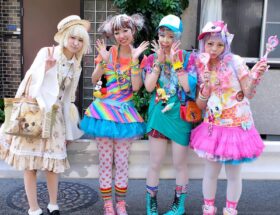Sustainable fashion, once a niche concept, has emerged as a powerful movement in the global fashion industry. As consumers become increasingly conscious of the environmental and ethical impacts of their clothing choices, the demand for sustainable fashion has skyrocketed. In this 2000-word article, we will explore the key aspects of sustainable fashion, its significance, challenges, and the transformative role it plays in shaping the future of the fashion industry and the planet.
Understanding Sustainable Fashion
Sustainable fashion, often referred to as eco-fashion or ethical fashion, is an approach to clothing design, production, and consumption that considers the well-being of the environment, society, and workers throughout the entire lifecycle of a garment. It seeks to minimize the negative impacts associated with the fashion industry, which traditionally includes issues such as pollution, waste, exploitation, and the overconsumption of resources.
The Impact of the Fashion Industry
Before delving into sustainable fashion, it’s essential to grasp the magnitude of the fashion industry’s environmental and ethical footprint.
- Environmental Impact: The fashion industry is one of the most resource-intensive industries globally, with significant contributions to pollution, water consumption, and greenhouse gas emissions. The production of textiles, dyeing processes, and the disposal of textile waste all have far-reaching consequences for the planet.
- Fast Fashion: The rise of fast fashion has led to a culture of disposable clothing, where cheaply made garments are worn briefly and then discarded. This cycle of rapid production and disposal exacerbates environmental issues and often involves exploitative labor practices.
- Labor Exploitation: The global supply chain of fashion relies heavily on low-cost labor in developing countries. Workers in many of these regions endure poor working conditions, low wages, and long hours, often without job security or social protections.
The Core Principles of Sustainable Fashion
Sustainable fashion rests on several fundamental principles that guide its ethos:
- Ethical Production: Sustainable fashion emphasizes fair labor practices and safe working conditions for all involved in the production process. This includes ensuring that workers receive fair wages and have the right to organize and negotiate collectively.
- Environmental Responsibility: Reducing the environmental impact of clothing production is central to sustainable fashion. This involves using eco-friendly materials, minimizing waste, and adopting clean and efficient production processes.
- Quality Over Quantity: Sustainable fashion encourages consumers to buy fewer, higher-quality items that are durable and timeless, thus reducing the need for constant replacement and disposal of clothing.
- Transparency and Accountability: Brands committed to sustainability are expected to be transparent about their supply chains, sourcing practices, and environmental and social impact. Accountability mechanisms ensure that they uphold their commitments.
- Circular Economy: The concept of a circular economy in fashion focuses on extending the lifecycle of garments through practices such as recycling, upcycling, and clothing rental, ultimately reducing textile waste.
Materials and Fabrics
One of the critical aspects of sustainable fashion is the use of eco-friendly materials and fabrics. Sustainable fashion brands employ various strategies to reduce their environmental impact:
- Organic Cotton: Organic cotton is grown without synthetic pesticides and fertilizers, reducing the harm to ecosystems and farm workers.
- Hemp: Hemp is a versatile and sustainable alternative to cotton, requiring fewer resources to grow and process.
- Recycled Materials: Brands increasingly use recycled materials like PET bottles, plastic waste, and reclaimed textiles to create new garments.
- Tencel and Lyocell: These fibers are derived from sustainably managed wood sources and produced through a closed-loop process that minimizes environmental impact.
- Animal-Free Alternatives: Sustainable fashion often embraces alternatives to traditional animal-derived materials, such as vegan leather made from plants and lab-grown textiles.
Sustainable Production Practices
The production phase of clothing manufacturing plays a crucial role in sustainable fashion:
- Local Production: Reducing the distance between production and consumption by manufacturing clothes locally reduces transportation-related carbon emissions.
- Slow Fashion: Slow fashion advocates for a more deliberate and considered approach to clothing production, emphasizing quality, durability, and timeless design over mass production.
- Zero-Waste Design: Designers committed to sustainability aim to minimize fabric waste by designing patterns that use the entire fabric, leaving little to no scraps.
- Energy-Efficient Production: Adopting energy-efficient machinery and processes, including the use of renewable energy sources, can significantly reduce the carbon footprint of clothing production.
Ethical Labor Practices
Ensuring ethical labor practices is a cornerstone of sustainable fashion:
- Fair Wages: Brands committed to sustainability pledge to pay fair wages to workers throughout their supply chain, which helps improve living standards and promotes economic stability.
- Safe Working Conditions: Safe and humane working conditions are non-negotiable in sustainable fashion. Brands strive to eliminate exploitative practices and provide a safe environment for their workers.
- Support for Artisans: Many sustainable fashion brands collaborate with artisans and small-scale producers, contributing to the preservation of traditional craftsmanship and skills.
Consumer Empowerment and Education
Sustainable fashion relies on an informed and conscious consumer base:
- Consumer Awareness: Educating consumers about the environmental and social impacts of their clothing choices is vital. Many organizations and resources provide information to help individuals make more sustainable choices.
- Ethical Consumerism: Ethical consumerism involves making choices that align with one’s values and ethics, including supporting brands with sustainable and ethical practices.
- Vintage and Secondhand Shopping: Choosing pre-loved clothing and participating in the circular fashion economy by buying vintage or secondhand items are sustainable alternatives to fast fashion.
Challenges and Criticisms
While sustainable fashion has made significant strides, it faces several challenges and criticisms:
- High Costs: Sustainable fashion can be more expensive due to the use of eco-friendly materials and ethical labor practices, making it less accessible to some consumers.
- Greenwashing: Some brands falsely market themselves as sustainable, a practice known as greenwashing. This can mislead consumers and dilute the impact of genuine sustainable efforts.
- Limited Accessibility: Sustainable fashion may not be readily available in all regions or accessible to people with lower incomes.
- Consumer Behavior: Changing consumer behavior and overcoming the allure of fast fashion are significant challenges in promoting sustainability.
The Impact of Sustainable Fashion
Sustainable fashion has begun to reshape the fashion industry and society in several ways:
- Awareness and Consciousness: Sustainable fashion has raised awareness about the environmental and social consequences of clothing production, prompting more conscious consumer choices.
- Innovation: The pursuit of sustainability has driven innovation in materials, production processes, and business models within the fashion industry.
- Influence on Mainstream Fashion: Sustainable fashion has influenced mainstream brands and designers, leading to the adoption of eco-friendly practices and materials.
- Economic Growth: Sustainable fashion has contributed to the growth of a niche market, creating opportunities for entrepreneurs, artisans, and sustainable fashion startups.
- Policy and Regulation: Governments and international bodies are increasingly recognizing the need to regulate the fashion industry’s environmental and ethical practices.
Sustainable Fashion and the Future
The future of fashion is inextricably linked to sustainability. As the fashion industry grapples with its environmental and social responsibilities, several trends and developments are expected to shape its trajectory:
- Circular Economy: The circular fashion economy will continue to gain traction, with more brands embracing practices such as garment recycling and upcycling.
- Innovation in Materials: Sustainable materials, such as lab-grown textiles and biodegradable fabrics, will become more prevalent in fashion.
- Transparency and Accountability: The fashion industry will see increased transparency and accountability, with brands disclosing their supply chain information and environmental impact.
- Consumer-Led Change: Consumers will play an even more significant role in driving change by demanding sustainability and supporting brands that align with their values.
- Regulation and Policy: Governments may introduce stricter regulations to ensure that the fashion industry complies with environmental and ethical standards.
Conclusion
Sustainable fashion is more than just a trend; it’s a necessity. It represents a transformative shift in the fashion industry, a movement that addresses critical issues related to the environment, labor, and consumption. As consumers become more conscious of their clothing choices and demand transparency and accountability from brands, sustainable fashion will continue to gain momentum. The fashion industry must adapt and embrace sustainability to ensure a greener, more ethical future for clothing production and consumption. It’s a journey that will require collective effort from consumers, brands, and policymakers alike, but the rewards are a more sustainable planet and a fashion industry that serves the well-being of all.









